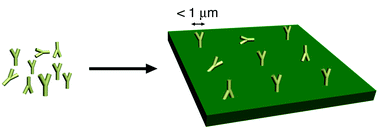Nanopatterning proteins and peptides
Abstract
A variety of techniques have been developed to site-specifically immobilize biomolecules onto surfaces with resolutions below one micron. The ability to pattern

* Corresponding authors
a Department of Chemistry and Biochemistry, 607 Charles E. Young Drive East, Los Angles, CA 90095-1569
b
California NanoSystems Institute, University of California Los Angeles, 6722 Boelter Hall, Los Angles, CA 90095-7151
E-mail:
maynard@chem.ucla.edu.
Fax: 01 310 825 0767
Tel: 01 310 267 5162
A variety of techniques have been developed to site-specifically immobilize biomolecules onto surfaces with resolutions below one micron. The ability to pattern

 Please wait while we load your content...
Something went wrong. Try again?
Please wait while we load your content...
Something went wrong. Try again?
K. L. Christman, V. D. Enriquez-Rios and H. D. Maynard, Soft Matter, 2006, 2, 928 DOI: 10.1039/B611000B
To request permission to reproduce material from this article, please go to the Copyright Clearance Center request page.
If you are an author contributing to an RSC publication, you do not need to request permission provided correct acknowledgement is given.
If you are the author of this article, you do not need to request permission to reproduce figures and diagrams provided correct acknowledgement is given. If you want to reproduce the whole article in a third-party publication (excluding your thesis/dissertation for which permission is not required) please go to the Copyright Clearance Center request page.
Read more about how to correctly acknowledge RSC content.
 Fetching data from CrossRef.
Fetching data from CrossRef.
This may take some time to load.
Loading related content
